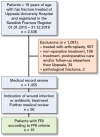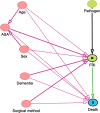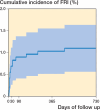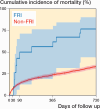Fracture-related infections after osteosynthesis for hip fracture are associated with higher mortality: A retrospective single-center cohort study
- PMID: 39311483
- PMCID: PMC11418272
- DOI: 10.2340/17453674.2024.41980
Fracture-related infections after osteosynthesis for hip fracture are associated with higher mortality: A retrospective single-center cohort study
Abstract
Background and purpose: Fracture-related infections (FRIs) after osteosynthesis for hip fractures have not been thoroughly investigated. Our primary aim was to assess the association between FRIs and mortality after osteosynthesis for hip fracture. Secondary aims were to investigate the incidence, microbiology, and general epidemiological aspects of these FRIs.
Methods: This retrospective single-center study included 1,455 patients > 18 years old with non-pathological hip fractures treated with osteosynthesis between 2015 and 2019. Medical records were reviewed and FRIs were diagnosed based on current consensus criteria. The follow-up period was 2 years. Mortality was estimated using Kaplan-Meier survival analysis. Cox regression analyses were performed to investigate the potential association between FRIs, as a time-dependent variable, and increased mortality.
Results: The median age for the entire cohort was 83 (interquartile range 75-89) years and 69% were females. At the 2-year follow-up mark, the crude mortality rate was 33% in the non-FRI group and 69% (11 of 16 patients) in the FRI group. Cox regression analysis assessing mortality risk revealed a hazard ratio of 3.5 (95% confidence interval [CI] 1.9-6.4) when adjusted for confounders. The incidence of FRI was 1.1% (16 of 1,455 patients). Staphylococcus aureus was the most common pathogen. Most FRI patients (94%) required at least 1 revision and 56% underwent ≥ 2 revision.
Conclusion: We found an association between FRIs after hip fracture osteosynthesis and increased mortality, underscoring the critical need for FRI prevention measures in this frail patient group. The incidence and microbiological findings were consistent with previous studies.
Figures




Similar articles
-
Ninety-Day Follow-up Is Inadequate for Diagnosis of Fracture-related Infections in Patients with Open Fractures.Clin Orthop Relat Res. 2022 Jan 1;480(1):139-146. doi: 10.1097/CORR.0000000000001911. Clin Orthop Relat Res. 2022. PMID: 34351311 Free PMC article.
-
Fracture Risk Indices From DXA-Based Finite Element Analysis Predict Incident Fractures Independently From FRAX: The Manitoba BMD Registry.J Clin Densitom. 2019 Jul-Sep;22(3):338-345. doi: 10.1016/j.jocd.2019.02.001. Epub 2019 Feb 8. J Clin Densitom. 2019. PMID: 30852033
-
[Incidence, Diagnosis and Risk Factors for Fracture-Related Infection (FRI): 3-Year Experience of Level I Trauma Centre].Acta Chir Orthop Traumatol Cech. 2023;90(3):211-218. Acta Chir Orthop Traumatol Cech. 2023. PMID: 37395429 Czech.
-
Periprosthetic fractures around hip hemiarthroplasty performed for hip fracture.Injury. 2013 Jun;44(6):757-62. doi: 10.1016/j.injury.2012.09.015. Epub 2012 Oct 25. Injury. 2013. PMID: 23103113 Review.
-
Outcomes of fracture-related infections - do organism, depth of involvement, and temporality count?J Orthop Surg (Hong Kong). 2022 Sep-Dec;30(3):10225536221118519. doi: 10.1177/10225536221118519. J Orthop Surg (Hong Kong). 2022. PMID: 36545946 Review.
References
-
- Folbert E C, Hegeman J H, Gierveld R, Netten J J v, Velde D v d, Duis H J T, et al. . Complications during hospitalization and risk factors in elderly patients with hip fracture following integrated orthogeriatric treatment. Arch Orthop Trauma Surg 2017; 137(4): 507-15. doi: 10.1007/s00402-017-2646-6. - DOI - PubMed
MeSH terms
LinkOut - more resources
Full Text Sources
Medical

